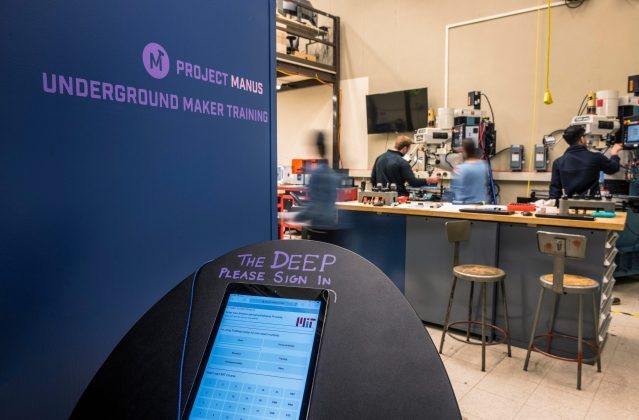Emily Makowski | School of Engineering
April 8, 2019
Hidden away in the basement of Building 37, two small rooms are filled with band saws, hacksaws, 3-D printers, laser cutting printers, and a variety of other tools large and small. A painted mural of a squid holding power tools greets visitors at the entrance. Wall art of a word cloud depicts some of the space’s values: respect, responsibility, and collaboration.
Welcome to The Deep, a new makerspace open to the MIT community. It is the latest output of Project Manus, an initiative to establish, update, and integrate makerspaces on campus.
During the week of March 11, The Deep hosted five open houses to draw attention to its 1,239-square-foot space, which started offering training to students in the summer of 2018. At the open houses, students were offered pizza, tours, and basic safety training amid examples of the creations they would be able to make themselves in the space: 3-D-printed frogs, an intricately carved wooden insect, and engraved boxes.
“What we’ve learned about these designing and building spaces is that it’s not the equipment or the space that that makes them work well. It’s how they’re run,” says Marty Culpepper, a professor of mechanical engineering.
Culpepper is known as MIT’s “Maker Czar” and is the head of Project Manus under Provost Martin A. Schmidt and the MIT Innovation Initiative. “What makes The Deep unique is that the students have a lot of ownership, and the students help run the space,” Culpepper says.
Seth Avecilla MArch ’08, a maker technical specialist, helped coordinate and conduct the tours and safety training during the open house. He says The Deep will offer open hours, training classes, and student mentors. The space currently has 15 active mentors, and Avecilla would like to see the number double or triple to better accommodate demand among students.
“Part of our mission is to try different methods of training,” he says “We’re about to get super busy — we hope.”
Robyn Goodner, a fellow maker technical specialist and organizer at The Deep, was pleased with turnout at the open houses. “They’ve been super packed. Monday to Wednesday we trained over 200 people,” she says.
The Deep is open to the entire Institute; students, staff, faculty, and alumni are all welcome to use the makerspace after completing training. It is connected via Project Manus to a broad network of makerspaces and maker programs around the MIT campus. In the spring of 2016, Culpepper and his team located, mapped out, and made available the 130,000 square feet of MIT space that has been devoted to making through an app, Mobius. At the same time, Vice Chancellor Ian Waitz — who was then the dean of engineering — helped launch MakerBucks, a program that provides every first-year MIT student who undergoes introductory training with $50 for materials to use in the makerspace of their choosing.
With ties to the other makerspaces under Project Manus, The Deep is strengthening the connections between the already-existing makerspaces.
“We are positioning The Deep to be a central hub of a more closely networked group of makerspaces that basically make it possible for the students to traverse seamlessly through that network.” says Culpepper. “There’s the formation of this larger MIT makerspace community that will revolve around The Deep, which will be good for the students in all kinds of different ways.”
Students who attended The Deep’s open houses expressed excitement about the makerspace.
“I have access to a lot of spaces, but I’m immensely impressed by the technical expertise that has accumulated with Project Manus in The Deep,” says Jacob Minke, a junior studying nuclear science and engineering and mechanical engineering. “It takes a deep level of understanding to do a hands-on project.”
Natasha Stark, a junior studying biological engineering who is interested in using The Deep’s laser cutting equipment, says she likes the space because it “is convenient and has better machines.”
“The part I’m most excited about is that it is explicitly for everybody,” she says.
Roberto Bolli, a junior studying mechanical engineering, agrees.
“A space like this will be incredibly useful,” he says. He adds that he has felt limited at times by other, smaller makerspaces where “the most you can hope for is some woodworking tools.”
The name “The Deep” was chosen by the community involved with the creation of the makerspace. It plays off the fact that the makerspace is located underground, and is an analog reference to deep learning — not the kind involving artificial intelligence or computing, but the type of deep knowledge involved in refined manual techniques, design, and fabrication.
The Deep is itself a kind of experiment that Culpepper is using to develop ideas for the approximately 17,000-square-foot makerspace planned for the remodeled Metropolitan Storage Warehouse, which is estimated to be completed in 2022.
“The Deep is actually what we call an R&D makerspace,” Culpepper says. “We do making in there like normal, but we also run loads of experiments to figure out how to do making better. Through the research in The Deep, we’re going to find out what is the best way to maximize the amount of benefit for the students while minimizing the amount of resources required to deliver that.”
Reprinted with permission of MIT News.
Photo: Christopher Harting

